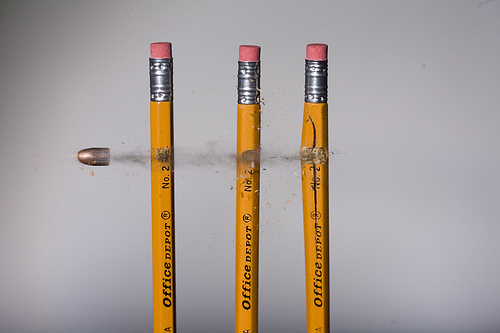Stop That Bullet
 Shawn the sharpshooter was practicing his shooting by firing at wooden blocks several meters away.
Shawn the sharpshooter was practicing his shooting by firing at wooden blocks several meters away.
If the bullet (point mass) loses half of its velocity (due to friction) upon penetrating 3.0 cm in a wooden block, then how much further (in cm) will it penetrate before coming to rest ?
Image credit: Linda Scearce
The answer is 1.0.
This section requires Javascript.
You are seeing this because something didn't load right. We suggest you, (a) try
refreshing the page, (b) enabling javascript if it is disabled on your browser and,
finally, (c)
loading the
non-javascript version of this page
. We're sorry about the hassle.
6 solutions
Discussions for this problem are now closed
if u don't mind why KE changes by a factor of 3/4 ? i just don't understand the relation
Since the final KE : initial KE = 1/4 Therefore the KE had changed 3/4 of its magnitude in 3 cm
There is a linear relationship between distance penetrated and energy lost due to friction (since the equation is W = F ∣ ˙ r ∣ , and the frictional force is constant).
Then, since the initial velocity is halved, 4 3 of the energy is lost. There remains a third of that energy left to lose, so it will take another 1 centimeter.
As an exercise, it may help to show what I said in a more formal, mathematical way.
v^2=u^2-2fx.........for first case u=t , v=t/2 , x=3.0cm....so from the equation f=(t^2)/8......now v=0 , u=t , f=(t^2)/8........now from equation x=4.0cm.....so it will go more 4.0-3.0=1cm
A spherical metal ball of mass 0.5 kg moving with a speed of 0.5 m/sec on a smooth linear horizontal track collides head on with another ball B of same mass at rest . Assuming the collision to be perfectly elastic ,what are the speed of A and B after collision ?
applying work energy theorem
(1/2)mv^2 - F*3 = 1/2m(v/2)^2
F= (mv^2)/8
(mv^2)/8 * x = mv^/2
this gives x=4
since it has alreadu travelled 3 cm so iit will travel 1cm more
since, v^2 -u^2=2as, v=v,u=v/2, s=3, substitute a=v^2 /8, now use v=v,u=0,a is calculated, s is found to be 4, 3 is already moved,therefore 1 is left
by the given information, let the initial velocity be x and we are given that it loses half of its velocity when it penetrates 3 cm. therefore its velocity after 3cm = x/2. Now applying 3rd equaiton of motion, i.e. v^2 - u^2 = 2as x^2/4 - x^2 = 2 * 3 * a this gives acceleration = (-x^2/8) now when it comes to rest its velocity will be 0. again applying 3rd equation of motion 0^2 - x^2 = 2 * (-x^2/8) *s this gives s = 4cm now since it has covered 3 cm it needs to cover 1 cm more to stop
use newtons equation 3 :- v2 = u2 +2as twice in the problem.
sorry but its not newtons equation rather its kinematics equation
i n i t i a l K E = 2 1 m v 2 b u t v e l o v i t y b e c o m e s h a l f i n 3 c m ∴ f i n a l K E = 2 1 m ( 2 v 2 ) = 4 1 i n i t i a l K E t h u s K E c h a n g e s b y a f a c t o r o f 4 3 4 3 d r o p i n K E → 3 c m ∴ r e m a i n i n g 4 1 d r o p i n K E → 1 c m